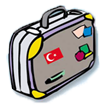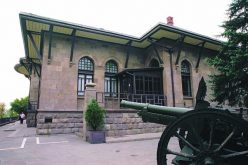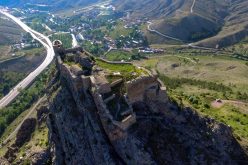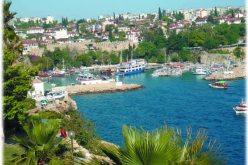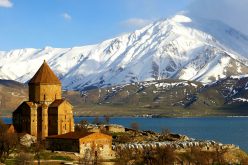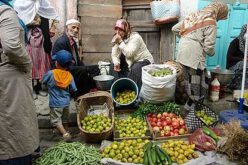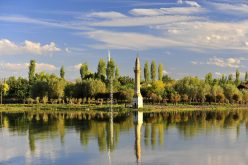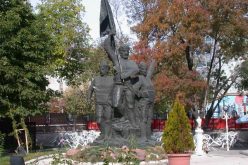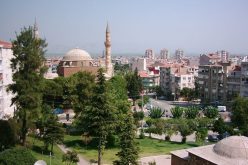Diyarbakır
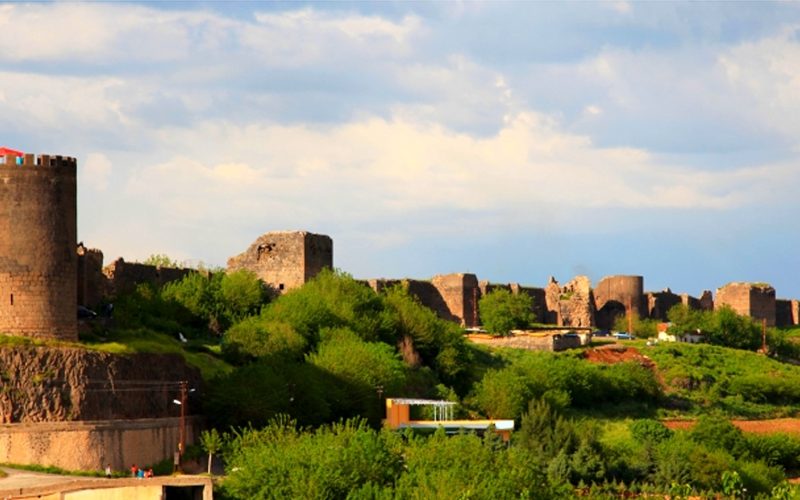
Diyarbakır
Diyarbakır ; Turkified form of Diyarbekir is als is the largest city in Southeastern Anatolia, on the banks of Tigris (Dicle), one of the greatest rivers of Middle East and considered by many to be the most beautiful city of the southeastern Turkey.
Get in[edit]
Turkish Airlines [2] offers daily domestic flights from Istanbul (IST) and Ankara to Diyarbakir (DIY).
Direct trains (the Guney Kurtalan Express) run five days a week from Ankara to Diyarbakir, taking 21 hours. There are couchettes and a sleeping car. The main stops along the route are Kayseri, Sivas, and Malatya; from Diyarbakir the train continues to Kurtalan, another 3 hours. For details see Turkish railways website at tcdd.gov.tr, but beware that the timetable and the online booking system give different days of running for this service. Note also that Ankara railway station is partially closed for rebuilding until early 2018, with bus replacements to Irmak 60 km east of the city, and altered timings.
Many local bus companies offer services from cities all over Turkey. The bus from Erzurum takes 6 hrs. The main bus station (otogar) is about 10 km away from city centre, along the highway to Urfa.
When traveling from Diyarbakir to west by bus be prepared for several ID check ups at military checkpoints.
Get around
See
The old city containing many mosques and churches, is a little run down but enclosed in antique walls. The city walls are very old and certainly worth a walk around. Some of towers are restored by the municipality and are easy to reach from the center of the old city. One such is Kechi Burcu, which offers a nice view of Tigris river below the city, and a great look over the city walls a teahouse offering traditional tea is nearby as well. However, be careful while walking on the walls and do not enter into all of the towers which looks fancy enough, as some of them are home to junkies.
The old city is like a village in the middle of the city with village mentality; goose running around, women having cay in front of their houses and kids (who’ll beg for money) shouting to foreigners the few English words they know. However, walking around in the city center is unique and totally different from other Turkish cities. You’ll see people as they live their everyday kurdish life. If you are lucky, you may even get invited for a tea by a friendly shop owner.
To avoid problems, dress modestly. There is an extensive development outside including a pleasant park. It’s called Gazi Kösk and it contains many teahouses and traditional bed-like constructions, where you sink into cushions and drink tea while overlooking the Dicle river below.
Ulu Camii (The Great Mosque), Gazi Cd (In the centre of the Old Town, near the main crossroad). The oldest mosque in Anatolia, built in the 11th century by Malikh Shah, the Emir of the Seljuk Turks. Free. edit
Kervanseray, Gazi Cd (Opposite the Great Mosque). Old caravanserai, now used as a place for cafes, bookstores, and souvenir shops.
Meryem Ana Kilisesi (Mary Church), Ana Sokak 26, Suriçi (In the Old Town, close to Melik Ahmet Cd, signposts indicate where the church is). Limited visiting hours, posted on the entrance. A Syrian Orthodox church founded in 3rd century. If you are lucky, the priest will sing for you in Aramaic.
Armenian church, (Next to the Mary Church, signposts indicate where the church is). The largest Armenian church in the Middle East, this edifice was recently restored by municipality. The first inauguration for a long time was held in October 2011 and has since officially started to serve the local Armenian community. Free. edit
Do
You can go for a walk on the old city wall. Get onto it at the northern gate and walk anticlockwise to Mardin Gate. Great views of the surrounding area and the city and it’s free. Single tourists might be conspicuous, however, and should beware of pickpockets.
Many tourists only visit the old part of Diyarbakir, but don’t miss the totally new and modern New City. Around Ofis district you find a lot of nice bars and cafès filled with lots of students and young couples. Some Bars have livemusic, but better ask some locals on the street for that. Don’t worry about security issues as this part of the city is filled with policemen.
Buy
In the old city you will find many people manufacturing metal tools by hand – sickles, hammers, and other, mostly agricultural implements.
You can also find cheap traditional kurdish trousers, that older men wear everyday. Enjoy tea + bargaining sessions with some friendly Bazaar shopkeepers.
Eat
Hasan Pasha Hani, Best place to get breakfast in Diyarbakir, located in an old caravanserai. Breakfast consists of your entire table being covered in many small dishes of tasty foods. Expensive for local standards but still very affordable, and delicious.
Buket Lahmacun, One of the most popular and most tasty places in Diyarbakir to try lahmacun (lahmajun), thin crispy dough covered in meat and spices. Is very tasty and quite cheap. Comes with many salads.
Dağ Kapı Ciğercisi, Restaurant popular with locals for its grilled liver on a skewer. The restaurant is located in an old house and is very big. Popular with locals.
A must try is seropeh (ser û pê) which is a traditional kurdish stew made from the head and feet of a sheep. Very cheap and tasty. Restaurants serving this dish are very common in Diyarbakir, just look for lamb skulls displayed in the window.
The grill of lamb liver, ciğer kebabı, is a famous part of Diyarbakır cuisine.
Ekşili etli dolma, meftune, içli köfte are some other “must taste”s.
A mixture of wheat grain, chick-peas, and yoghurt called mehir is purpoted to be very good for stomach and is said to help healing stomach problems.
Diyarbakır is very famous with its desserts. Kadayıf, künefe are the two main types of desserts. They are acquired tastes, though, as they are very sweet and contain huge amounts of sugar. Saim Usta is perhaps the best place to have kadayıf in town, while for künefe, you should check out Levent Usta.
Drink
There are many teagardens in Ofis and along the Basalt city walls, where you can meet locals. People in Diyarbakir are very open towards foreigners and you’ll have a hard time paying for your own tea.
Mahya Kahve Evi (Mahya Coffee House), Dicle sokak 2a (In Ofis, just off the main street where buses run from bus station to city center), ([email protected]). Open till late at night. This coffeehouse (mahya means “mosque lamp made of coloured glass”) has over 70 varieties of coffee and a nice interior. The owners and customers are very friendly and easy going.
Tigris Cafe Nargile Salonu, Camii Sk. (now apparently called Sanat Sokak) Cüneyt Bey Apt Altı 16/B (In Ofis, near Yeşil Camii), ☎ +90 412 228 28 84. Apart from nargilas, you can drink there delicious menengiç kahvesi, which is a very sweet milk based drink, a local speciality. The Tigris also has European style toilets available if you should be desperate.
Hasan Paşa Hanı, Kıbrıs Cd, ([email protected]). Besides coffee and tea, you can have an extremely rich breakfast and/or brunch here in the 500-year-old inn’s nice atmosphere.
Ninova Cafe, Sanat Sokağı (At Ofis, ask for the Sanat Sokağı; it’s on the middle), [1]. 11:00-23:00. Coffee, tea, menengiç coffee, hot wine etc. cheap.
Sleep
There are many clean and reasonably comfortable hotels with air con, etc. around Inönü street, in the modern part of the old city. Cheap options are also available around Dagkapi square if you want to avoid dodgy areas at night but still within the old wall. One cheap option is Divan Otel at Gazi Cad. # 9. Hotel Surkent, Hz. Suleyman Cd, 19 (Close to the wall and center.), ☎ +90 412 228 1014. checkout: 11AM. It is a clean place, well located and with a very reasonable price. Air-conditioning, heating, small fridge, comfortable beds, hot shower, western toilets, flat-screen TV, English-speaking staff.
Aslan Hotel, Kıbrıs Cd. Budget-friendly hotel.
Hotel Ekin (not ‘Hotel Evin’ as one popular guide book calls it). The hotel is very clean, good views from the breakfast lounge at the top. The windows are good and have to be due to the traffic noise and frequent honking of municipal buses in front of the hotel. It’s easy to get into the newer part of the city. The best locations for nighttime cafes etc is called Ofis. This area is about 20 minutes walking distance from the hotel and safe at night. Go to the big junction to the right of the hotel and cross over to the other side of the city walls. Kıbrıs Cad. No:35/B Dağkapı Telephone: +90 (412) 224 90 01 – 02 GSM: +90 (546) 421 21 00 Fax: +90 (412) 224 90 03 E-Mail: [email protected] – [email protected]
GAP otel. Down a dark and smelly cul de sac in the northern part of the city, near the city walls. AC, TV, fridge and 24h hot water. The look of the place is really nice and the owner is friendly and will offer tea every time he sees you.
Diyarbakır is rough. At first glance, it seems not a very welcoming city, actually it is the contrary. It is not advisable at all to walk alone during the night time, especially in the old quarter. Taking some precautions during the visit is advisable, just common sense. Don’t hang around in dark areas; try not to look like the typical tourist, etc.
The lower end of the street toward the Mardin Kapı, the Mardin Gate, is pretty dark and can be dangerous at night. Do not become prey to pickpockets who seem to hang around there.
The modern part of Diyarbakir is very much safer.
However, Diyarbakir seems to have recovered from the old times and the police is trying its best to provide a high level of security. So don’t let you scare off from some issues mentioned above, as the city itself is still a jewel among others in eastern turkey, offering an amazing and unforgettable charm. Tourist crowds are still tending more to Mardin (1h away), so enjoy having the city mostly for your own.
Get Out
Hasankeyf — village to east, downriver on Tigris, with lots of medieval Islamic architecture and pleasant vistas
Mainly all other cities in eastern and southeastern Turkey.
Mardin and Şanlıurfa are both a day’s trip from Diyarbakir, but Mardin is worth spending the night. The dolmush from the otogar takes 2hrs.
Karacadag, the forerunner of domesticated wheat originated in the mountains of Karacadag. Cultivation of wheat in the area dates back to approximately 8,800 BCE. Today Karacadag is home to seasonal nomads. Explore the ancient villages populated by Turkmen and Kurdish tribes.
See where the first animals in the world were domesticated as mankind started settled farming at Çayönü around 40km north-west of Diyarbakir. The site is hugely important for neolithic research and dates from 7200 to 6600 BC
Write a Comment
Only registered users can comment.

